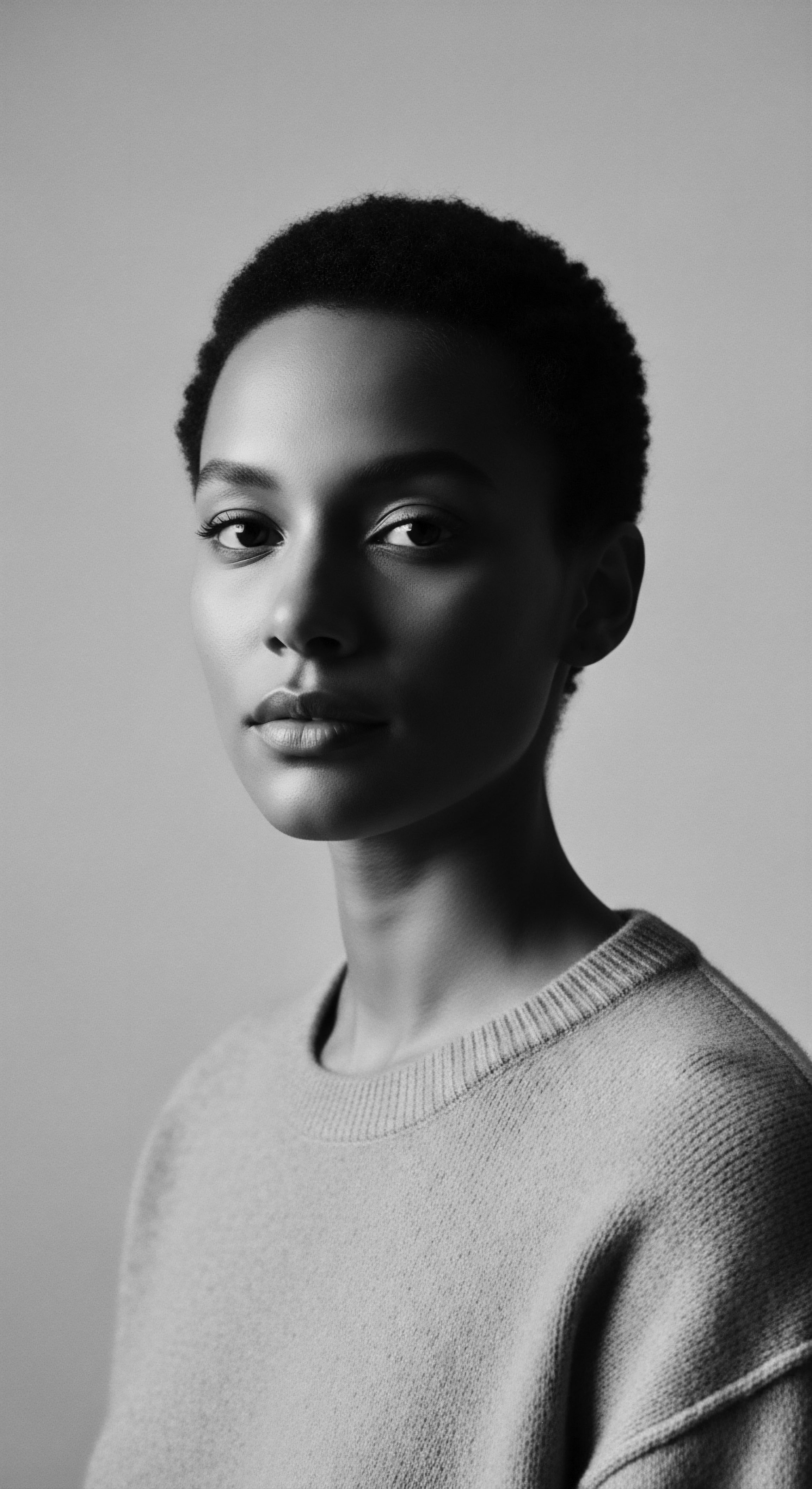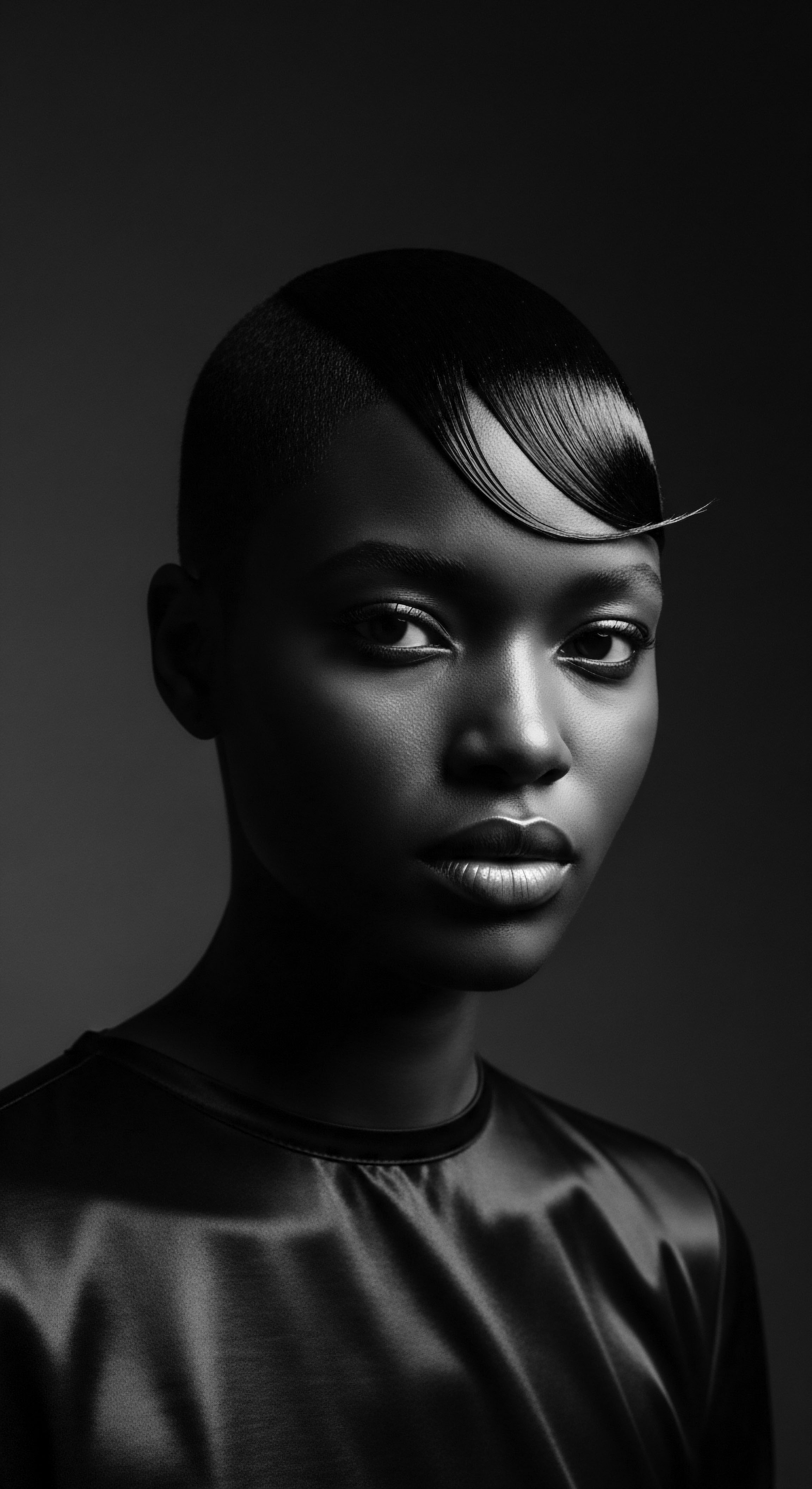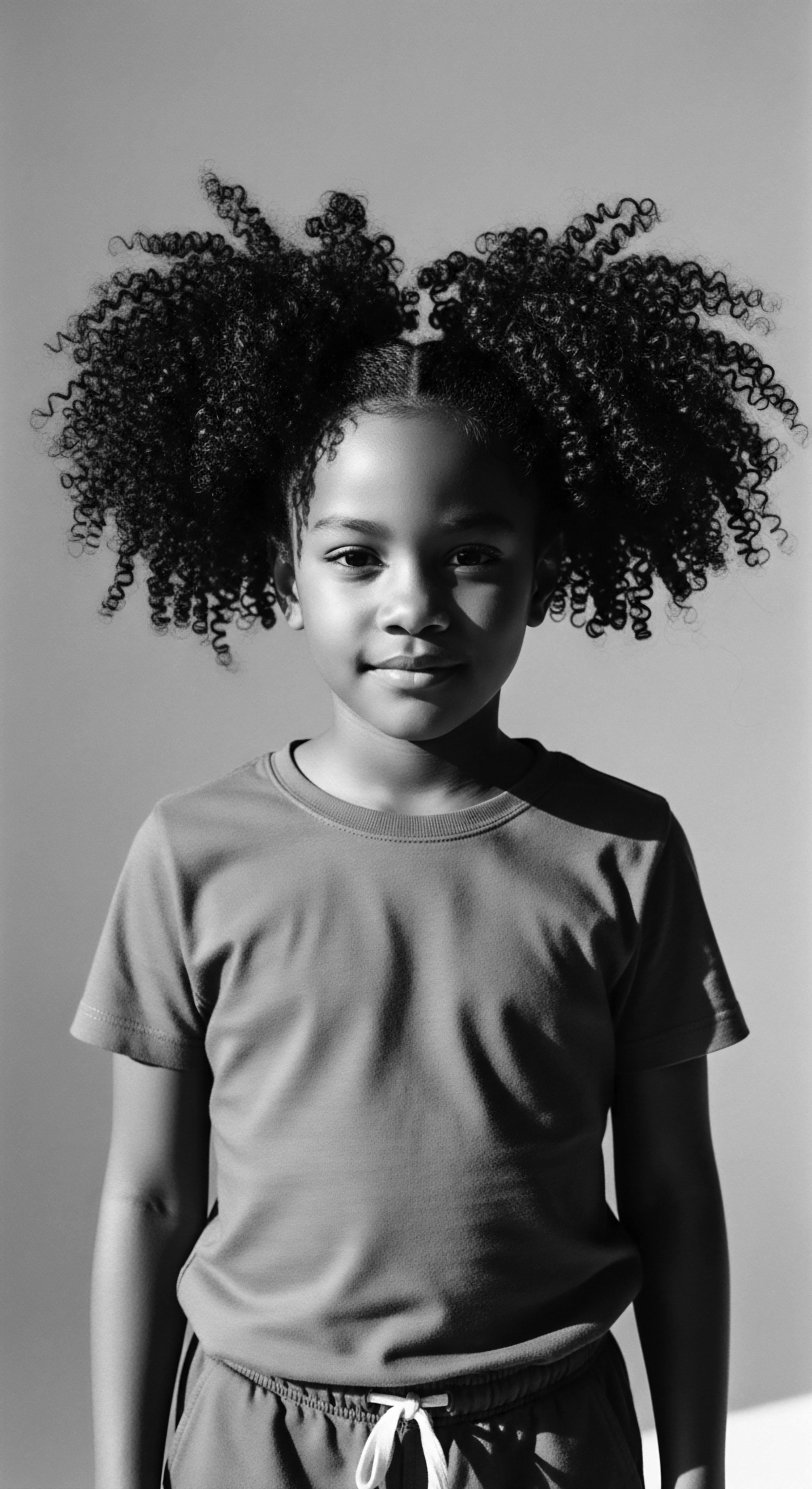
Roots
Across generations, from sun-drenched savannahs to bustling cityscapes, the hair that crowns Black and mixed-race individuals has always told a story—a story of resilience, of cultural memory, and of profound connection to ancestral ways. This isn’t merely about follicles and strands; it is about the very soul of a strand, imbued with the wisdom of those who came before us. Our exploration of what oils benefit textured hair stretches beyond modern formulations. It reaches back, touching the earth and the hands that first worked its bounty, understanding that care for our hair is an echo from the source, a continuation of practices born from intimate knowledge of the land and its gifts.
The unique curl patterns, the incredible density, the natural tendency towards glorious volume—these are not deviations from a norm, but rather expressions of unparalleled structural complexity and beauty. To understand which oils serve this hair best, we must first look with clear eyes at the hair itself, recognizing its singular anatomy and the ancestral lexicon that honored its distinctiveness.

Understanding the Inherited Architecture of Textured Hair
Textured hair, whether a tight coil or a loose wave, possesses a specific structural blueprint that sets it apart. Unlike straight hair, which tends to have a circular cross-section and grows straight out of the scalp, textured strands emerge from elliptical or oval follicles, causing the hair shaft to twist and turn. This helical growth pattern creates points of weakness along the strand where the cuticle layers lift, making the hair more susceptible to moisture loss and breakage. The journey of natural oils onto such a surface is therefore one of gentle reinforcement, of sealing and softening.
In ancient West African societies, for example, the observation of hair’s inherent dryness led to the traditional reliance on plant-based emollients. They intuitively understood what modern science now validates ❉ oils do not simply sit upon the hair; they interact with its very architecture. These ancestral practices, often communal and deeply ritualistic, developed without the aid of microscopes or chemical analyses, yet their wisdom persists.

What Distinguishes Hair Porosity and Its Ancestral Relevance?
The concept of hair porosity, though a contemporary term, finds its historical parallel in the ancestral understanding of how hair absorbed or repelled natural elements. Porosity refers to how readily your hair’s outermost layer, the cuticle, allows moisture to enter or escape. Hair with a tightly sealed cuticle has low porosity, while hair with a more open cuticle has high porosity. Textured hair often exhibits variations in porosity, influenced by genetics and daily care.
For generations, women and men of African descent developed care routines that, while not explicitly labeled by “porosity,” effectively addressed these varied needs. They learned through trial and observation which plant extracts and animal fats would truly sink into the hair and which would sit atop, offering a protective shield. This knowledge was passed down, often wordlessly, through the tender touch of a mother braiding her daughter’s hair, a practice echoing centuries of inherited wisdom.
Ancestral hair care wisdom, though unburdened by scientific nomenclature, intuitively understood the nuanced structural needs of textured hair.
The very language used to describe textured hair in various African and diasporic communities often spoke to its inherent qualities and needs. Terms for dry hair, for hair that breaks easily, or for hair that feels rough or parched, implicitly guided the application of certain nourishing agents.
Consider the foundational oils, those cherished agents of the earth that became cornerstones of traditional textured hair care. They were chosen not by chance, but by generations of collective insight, their virtues revealed through repeated application and observed benefit.
- Shea Butter ❉ From the nuts of the shea tree (Vitellaria paradoxa), native to West Africa, shea butter has been a staple for millennia. Its rich, creamy texture and profound moisturizing properties made it invaluable for protecting hair and skin from the harsh sun and dry air. Archaeological findings at the Kirikongo site in Burkina Faso, dating from 100-1700 CE, confirm its widespread production and use in ancient communities (Gallagher et al. 2023).
- Castor Oil ❉ Though its origins are global, the use of castor oil (Ricinus communis) for hair has a particularly deep history within the African diaspora. It was a plant that traveled across oceans, its seeds carried by enslaved Africans, who continued to apply its thick, emollient substance to their scalps and strands, believing in its power to promote growth and strength, often in defiance of dehumanizing conditions (Carney, 2004).
- Baobab Oil ❉ Extracted from the seeds of the majestic baobab tree, often called the “Tree of Life” in Africa, this oil holds a respected place in traditional pharmacopeia. Its ability to lock moisture into strands, drawing from the tree’s own water-retaining prowess, made it ideal for conditioning hair and promoting its natural sheen, even in arid climates.
Each of these oils carries the weight of history within its very molecular structure, a silent testament to the ingenuity and enduring legacy of those who first discovered their potent properties for textured hair.

Ritual
The application of oils to textured hair has never simply been a cosmetic act; it is a ritual, a tender thread woven through the fabric of family, community, and personal identity. These practices, passed from elder to youth, transcended mere maintenance, becoming moments of shared wisdom, of comfort, and of cultural affirmation. When we speak of oils benefiting textured hair, we are also speaking of the hands that applied them, the stories shared during those moments, and the profound sense of belonging that these traditions carried across generations and geographies.
Through the ebb and flow of history, from pre-colonial kingdoms to the challenging realities of the diaspora, hair practices remained a steadfast anchor. Oils played a central role, not only for their tangible benefits but for their symbolic weight within these living traditions of care.

How Did Ancient Practices Inform Modern Oil Usage for Textured Hair?
In many ancestral African societies, hairstyling was an elaborate art form, with intricate braids, twists, and coils conveying messages about age, marital status, social standing, and tribal affiliation (Johnson & Bankhead, 2014). Oils were essential to these designs, providing lubricity for easier manipulation, sealing in moisture to preserve the style, and contributing a healthy sheen that communicated vitality. The preparation of these oils often involved communal effort, from harvesting shea nuts in the savanna to pressing seeds by hand, reinforcing community bonds.
One such enduring practice is the use of Jojoba Oil, although its primary botanical origin lies with indigenous American cultures, its functional qualities, mimicking the scalp’s natural sebum, resonated powerfully with Black beauty traditions, emphasizing nourishing, protective, and reparative care. In the 1970s, as the Black is Beautiful movement gained momentum, a focus on natural hairstyles and Black-owned beauty products grew. Jojoba oil’s inclusion in regimens during this era became an act of self-affirmation against Eurocentric beauty ideals, aligning with a broader embrace of cultural authenticity and an inherited desire for natural solutions (BeautyMatter, 2025). This cultural adoption showcases how oils, regardless of their precise geographical origin, could become deeply integrated into the heritage of textured hair care based on shared needs and a collective spirit of self-determination.
The legacy of these traditional methods endures today. Modern protective styles, like braids, twists, and locs, continue to draw upon these ancestral principles, and oils remain a cornerstone. They reduce friction, minimize breakage, and maintain moisture, preserving the integrity and longevity of these styles.
| Historical Application Communal Oiling Ceremonies ❉ Often part of rites of passage or social gatherings, oils like shea butter were massaged into scalps and strands, symbolizing blessing and collective well-being. |
| Modern Relevance for Oils Scalp Massage for Growth ❉ Contemporary understanding highlights improved blood circulation and nutrient delivery, echoing the historical belief in holistic hair health. Oils like peppermint or rosemary, diluted in carrier oils, are applied. |
| Historical Application Hair as Social Marker ❉ Intricate styles, secured and hydrated with oils, communicated identity, status, or tribal affiliation. |
| Modern Relevance for Oils Defining Curl Patterns ❉ Oils aid in clumping curls, reducing frizz, and enhancing definition, reflecting a desire to showcase the natural artistry of textured hair. |
| Historical Application Protection from Elements ❉ Shea and baobab oils created a physical barrier against sun, wind, and dryness for those living outdoors. |
| Modern Relevance for Oils Environmental Shield ❉ Oils continue to offer a protective layer, guarding against humidity, pollution, and mechanical stress, maintaining hair integrity in diverse environments. |
| Historical Application The enduring presence of oils in textured hair care underscores a continuous cultural thread from ancient protective practices to modern beauty rituals. |

What Oils Lend Themselves Best to Traditional Styling and Definition?
Certain oils, by their very nature, were favored for their tangible contributions to styling textured hair. Their molecular structures and fatty acid profiles allowed for specific actions that assisted in forming and holding desired shapes, while also delivering vital nourishment.
For definition, lighter oils or those that could be warmed to a liquid state and then allowed to solidify slightly were prized. They would coat the individual strands, allowing them to clump into distinct curl patterns rather than frizzing. Think of the ancestral applications where a small amount of oil, perhaps warmed by the sun, was worked through freshly washed hair before coiling or twisting.
The selection of oils in traditional styling was a testament to observational wisdom, aligning the oil’s properties with the hair’s natural inclinations.
Marula Oil, for instance, a visitor from southern Africa, with its light-yellow color and not-too-thick formula, would have been an exceptional choice. For centuries, women from the Ovambo tribe in Namibia used marula oil as a universal cosmetic for hair and body (NANOIL Oils, n.d.). Its quick absorption and rich content of monounsaturated fatty acids make it ideal for adding shine, reducing frizz, and creating a soft, supple texture without weighing down delicate coils (Kérastase Australia, n.d.). Its tradition within Zulu culture, known as the “marriage tree,” symbolizes fertility and purity, underscoring the deep cultural ties that oils possess beyond their mere physical attributes (O&3, 2024).
These choices were not arbitrary; they were the culmination of generations of meticulous observation and hands-on experience, passed down through the intimate exchange of hair care.

Relay
The journey of textured hair care, especially through the lens of ancestral oils, is an ongoing relay race of wisdom—each generation passing the torch of knowledge, adapting it, and adding new insights to the collective heritage. The science of today, far from dismissing these ancient practices, often offers profound validation, illuminating the biological mechanisms behind effects understood intuitively for centuries. Our understanding of what oils benefit textured hair gains immense depth when seen as a dialogue between the historical archives of practice and the expanding library of modern scientific inquiry. This interplay allows us to voice identity through our strands and shape the future of care.
In analyzing the efficacy of traditional oil use, particularly in the context of the African diaspora, we bridge gaps between lived experience and laboratory findings. This deep dive into the properties of these cherished oils reveals not only their immediate cosmetic advantages but also their broader contributions to scalp health, strand integrity, and ultimately, hair longevity, all rooted in practices developed over millennia.

How Do Traditional Oils Promote Scalp Health and Hair Growth?
The tradition of oiling the scalp for healthy hair growth is deeply embedded in various diasporic communities. For enslaved Africans in the Americas, removed from their traditional cleansing herbs and natural oils, the resourceful use of readily available cooking oils or animal fats became a means of survival for their hair, despite the limitations (Cripps-Jackson, 2020). These practices, born of necessity, evolved into resilient traditions focused on maintaining scalp vitality, a practice now understood through a scientific lens.
Consider the case of Castor Oil. Widely used in the African diaspora for promoting hair growth, its dense viscosity and unique fatty acid profile have long been associated with stimulating follicles. While systematic reviews note weaker evidence for direct hair growth from castor oil, they do acknowledge its traditional use for improving hair quality by increasing luster, a testament to long-held observations (Phong et al. 2022).
This cultural belief, persisting for centuries, points to an experiential truth that scientific investigation is still striving to fully unpack. The oil, derived from the castor bean plant, was established early in Brazil and introduced to Santo Domingo from Africa by 1509 (Carney, 2005). The plant’s ubiquity in tropical plantation societies and broad curative properties attracted commentary from many European observers, yet it was the enslaved who applied it with a deep understanding of its localized benefit for hair and skin.
The centuries-old use of ancestral oils for textured hair represents an intersection of intuitive wisdom, cultural resilience, and emerging scientific validation.
Moreover, oils like Baobab Oil, rich in omega-3 fatty acids, possess anti-inflammatory properties that can soothe an irritated scalp, creating a more favorable environment for growth (Healthline, 2020). This aligns directly with ancestral wisdom that linked a healthy scalp to healthy hair. The traditional African pharmacopeia consistently included ingredients that addressed underlying scalp conditions, understanding that the health of the strand originates at its source.

What Role Do Occlusive and Penetrating Oils Play in Textured Hair Integrity?
Oils can be broadly categorized by their interaction with the hair shaft ❉ those that primarily sit on the surface, offering an occlusive layer, and those that can penetrate the hair cuticle. Understanding this distinction, though framed in modern scientific terms, aligns with the ancestral discernment of how different fats and oils truly behaved on their hair.
Occlusive Oils, like Shea Butter, form a protective barrier on the hair surface, preventing moisture loss, particularly crucial for hair that tends to dry out quickly due to its unique structure. This aligns with the historical use of shea butter for sun protection and environmental shielding, demonstrating a deep, intuitive grasp of its occlusive qualities. Its use was not merely for aesthetics; it was a fundamental tool for preserving the hair’s very life.
Conversely, some oils, due to their smaller molecular size and specific fatty acid profiles, are able to slip through the cuticle layers and hydrate the inner cortex of the hair. Coconut Oil is a prime example of a penetrating oil, with studies demonstrating its ability to reduce protein loss for both damaged and undamaged hair when used as a pre-wash or post-wash treatment (Rele & Mohile, 2003). This scientific finding echoes the widespread, ancient use of coconut oil in parts of the African diaspora and other tropical regions, where it was prized for its conditioning and strengthening attributes.
- Penetrating Oils ❉ These oils, such as Coconut Oil, possess smaller molecular structures, allowing them to pass beyond the cuticle into the hair’s cortex. They help replenish lipids lost during washing and styling, thus reducing protein loss and strengthening the strand from within.
- Sealing Oils (Occlusive) ❉ Oils like Jojoba Oil or Shea Butter create a lightweight film on the hair’s surface. This film acts as a barrier, preventing moisture from escaping the hair shaft and protecting it from environmental stressors, such as harsh winds or dry air.
- Nutrient-Rich Oils ❉ Many traditional oils, including Baobab Oil and Marula Oil, carry a wealth of vitamins, antioxidants, and fatty acids. These components nourish both the hair strands and the underlying scalp, contributing to overall hair health and vitality.
This layered understanding of oil function, from surface protection to internal nourishment, reflects an inherent wisdom present in ancestral hair care. It underscores that the selection of oils was not random; it was informed by a meticulous, generations-long empirical study of what sustained hair that defied conventional European standards, hair that held stories in its every coil.
The efficacy of these oils in addressing common concerns—dryness, breakage, lack of sheen—is not a modern discovery. Instead, it is a scientific articulation of what Black and mixed-race communities have always known, an affirmation of the relay of knowledge that has carried these traditions forward.

Reflection
As we draw our exploration to a close, the threads of history, science, and heartfelt tradition intertwine, revealing a profound truth ❉ the care of textured hair, especially through the timeless wisdom of oils, is a living, breathing archive of heritage. It is a story told not through words alone, but through the very touch of hands, the scent of plant-derived elixirs, and the resilience of strands that have endured and flourished across continents and centuries. Roothea’s ‘Soul of a Strand’ ethos finds its deepest resonance here, in the enduring legacy of how our ancestors engaged with their hair, seeing it as an extension of self, community, and spirit.
The oils that benefit textured hair are more than just cosmetic agents; they are vessels of memory, carrying the silent narratives of survival, adaptation, and unwavering self-acceptance. They remind us that the ingenuity of traditional practices, born from deep connection to the earth, laid the groundwork for our contemporary understanding. The pursuit of healthy, radiant textured hair today is a continuous act of honoring that rich lineage, a celebration of the inherited wisdom that persists against all odds. It is a powerful affirmation that our hair, in its myriad forms, is a testament to an unbroken ancestral chain, a source of pride that continues to write its own vibrant story.

References
- Carney, J. (2004). ‘With Grains in Her Hair’ ❉ Rice History and Memory in Colonial Brazil. Slavery & Abolition, 25(1).
- Carney, J. (2005). Rice and Memory in the Age of Enslavement ❉ Atlantic Passages to Suriname. Slavery & Abolition, 26(3).
- Cripps-Jackson, S. (2020). The History of Textured Hair. Colleen.
- Gallagher, D. E. et al. (2023). The Archaeology of Shea Butter (Vitellaria paradoxa) in Burkina Faso, West Africa. Journal of Ethnobiology, Sage Journals.
- Healthline. (2020, June 29). Baobab Oil Uses & Benefits Based on Research.
- Johnson, T. A. & Bankhead, T. (2014). Hair It Is ❉ Examining the Experiences of Black Women with Natural Hair. Open Journal of Social Sciences, 2(4).
- Kérastase Australia. (n.d.). Marula Oil for Hair Benefits & Uses.
- NANOIL Oils. (n.d.). Marula oil in hair care – wonderful rejuvenating elixir.
- O&3. (2024, January 25). Embracing the Rise of Marula Oil ❉ Market to Reach $31.2M by 2027.
- Phong, C. et al. (2022). Coconut, Castor, and Argan Oil for Hair in Skin of Color Patients ❉ A Systematic Review. Journal of Drugs in Dermatology, 21(7).
- Rele, J. S. & Mohile, R. B. (2003). Effect of Mineral Oil, Sunflower Oil, and Coconut Oil on Prevention of Hair Damage. Journal of Cosmetic Science, 54(2).
- BeautyMatter. (2025, February 4). The Untold Story of Jojoba Oil in Black Beauty.
